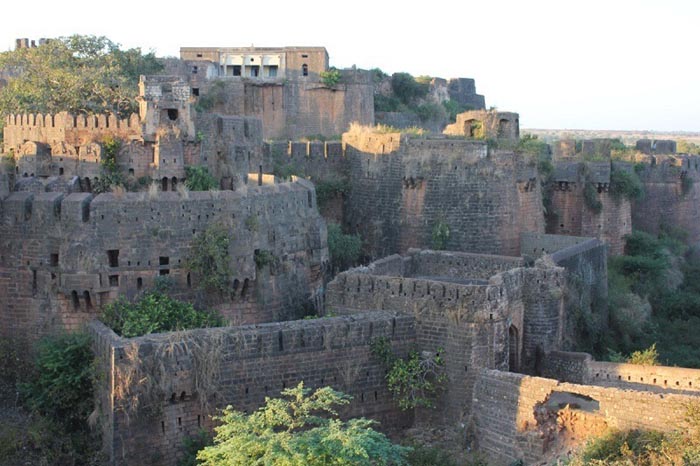Basavakalyan Fort

Information on Basavakalyan Fort (Bidar, Karnataka) - History & Architecture
Basavakalyan Fort which was also known as Kalyana Fort is situated in Bidar district of Karnataka. It was created by Chalukas in 10th century. Basavakalyan Fort has vital significance to Basavakalyan city, which is also famous for the originator of Virashaiva community. This fort was the core of great social and religious drive during 12th century. Many saints of Virashaiva community are related with Basavakalyan Fort. Furthermore, the fort was also regarded as a base of knowledge.
Basavakalyan Fort Architecture
Basavakalyan Fort was tactically created by considering defence mechanism in an imperceptible environment. The fort was not noticeable unless the enemies are at nearby distance. This locational benefit help to resist any enemy assaults. Basavakalyan Fort was created by intersecting huge rocks which are spread throughout the hills, along with robust walls. It has guard rooms and towers. There are three concentric asymmetrical walls in the fort.
Basavakalyan Fort was made of seven entrances, out of which only five entrances are in good condition. At the entrance of the fort, there is a dense arch with galleries on the edges which are reached by series of stairs. The fort walls enfolds the central yard with guard rooms, which are also joined with several supports and attached by cannons, some of which are decorated. The walls are decorated with pictures of Yalis. At the top of the entrance, openings can be observed, which were most probably used to drown the enemies with hot oil. There is also a deep channel in Basavakalyan Fort which acted as a defence system.
Chalukya rulers has decorated several Jain pictures in the walls of Basavakalyan Fort. There is a museum inside the fort which houses various Jain statues of 10th and 11th century. From the entrance, there is a way towards a fortress named Rajmahal palace. However, most of its parts have damaged in present days. Adjacent to the palace, there is a temple without any idol of god. There is a square shaped pool in front of the temple. Behind the temple, there is another fortress named Rani Mahal.
Basavakalyan Fort History
Basavakalyan Fort was regarded as headquarter of the royal capital of Chalukya family, i.e. Kalyana. They have ruled during the period of 1050 to 1195. Throughout 10th and 12th centuries, Chalukya family controlled about half portion of India. Later, in the year 1310, Basavakalyan Fort was attacked by Mallil Kafur through his invasion in southern side. In the 16th century, the king of Vijaynagar, Rama Raya found his heritage with the past Chalukyan realm along with the capital of Chalukya. He had united with various Muslim rulers of Deccan thru his sovereignty, in order to gain representative control over Basavakalyan Fort. In the year 1543, king Rama Raya defeated the king of Bidar and gave the control of the fort to the king of Bijapur. In 1549, the circumstance changed when king Rama Raya united with the king of Ahmadnagar and attacked Basavakalyan Fort. He gave the control of the fort to his ally. However, in the year 1558, after the death of the king of Bijapur, his son counterfeited the alliance with king Rama Raya and conquered the Ahmadnagar. As a result, Basavakalyan Fort was handed over to the son of Bijapur king who again gave the control of the fort to his friend Adil Shah. In the year 1561, king of Ahmadnagar attempted to capture Basavakalyan Fort but was overwhelmed by the forces of king Rama Raya and Adil Shah. However, king Rama Raya antagonised with the king of Bijapur as well as the king of Ahmednagar which lead to ultimate downfall of Vijayanagara Kingdom.
Basavakalyan Fort Tourism Importance
Basavakalyan Fort demonstrates the traces of different rulers who controlled the fort and renovated accordingly. There are several palaces, structures and temples inside the fort which can be enjoyed by tourists. Although at present, several parts of Basavakalyan Fort is in ruined condition, it is still worth visiting. Travellers can truly contemplate the historical glory of the fort along with its impressive architecture.
- Bangalore Monuments
- Bagalkot Monuments
- Belgaum Monuments
- Bellary Monuments
- Bidar Monuments
- Bijapur Monuments
- Chitradurga Monuments
- Coorg Monuments
- Dakshina Kannada Monuments
- Gadag Monuments
- Gulbarga Monuments
- Hassan Monuments
- Mysore Monuments
- Raichur Monuments
- Uttara Kannada Monuments
- Yadgir Monuments
- Andaman Nicobar Monuments
- Andhra Pradesh Monuments
- Assam Monuments
- Bihar Monuments
- Chhattisgarh Monuments
- New Delhi Monuments
- Goa Monuments
- Gujarat Monuments
- Haryana Monuments
- Himachal Pradesh Monuments
- Jammu and Kashmir Monuments
- Karnataka Monuments
- Kerala Monuments
- Madhya Pradesh Monuments
- Maharashtra Monuments
- Odisha Monuments
- Punjab Monuments
- Rajasthan Monuments
- Tamil Nadu Monuments
- Telangana Monuments
- Uttar Pradesh Monuments
- West Bengal Monuments